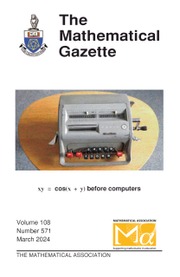No CrossRef data available.
Article contents
Recursive approach to repeated collisions
Published online by Cambridge University Press: 15 October 2025
Extract
Mathematics and physics are fascinatingly connected with each other. Since [1] first pointed out the relationship between the number π and the total number of collisions between two blocks and a wall, it has generated wide interest among the general public [2, 3, 4, 5]. A carefully made video presents an elegant and crystal clear geometric explanation [6], which is followed by a slightly more advanced explanation based on linear algebra, matrix formalism in particular [7]. References [2, 3, 6] attribute the geometric approach to different individuals, but the relationship actually appeared much earlier in a physics journal which focused on the number of collisions rather than its connection with the number π [8].
Information
- Type
- Articles
- Information
- Copyright
- © The Authors, 2025 Published by Cambridge University Press on behalf of The Mathematical Association


